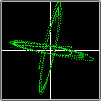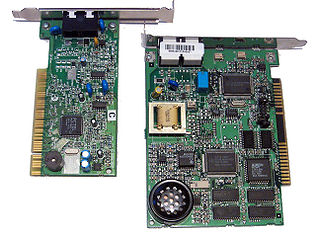In electronics and telecommunications, modulation is the process of varying one or more properties of a periodic waveform, called the carrier signal, with a separate signal called the modulation signal that typically contains information to be transmitted. For example, the modulation signal might be an audio signal representing sound from a microphone, a video signal representing moving images from a video camera, or a digital signal representing a sequence of binary digits, a bitstream from a computer.

In digital radio, packet radio is the application of packet switching techniques to digital radio communications. Packet radio uses a packet switching protocol as opposed to circuit switching or message switching protocols to transmit digital data via a radio communication link.

Radioteletype (RTTY) is a telecommunications system consisting originally of two or more electromechanical teleprinters in different locations connected by radio rather than a wired link. Radioteletype evolved from earlier landline teleprinter operations that began in the mid-1800s. The US Navy Department successfully tested printing telegraphy between an airplane and ground radio station in 1922. Later that year, the Radio Corporation of America successfully tested printing telegraphy via their Chatham, Massachusetts, radio station to the RMS Majestic. Commercial RTTY systems were in active service between San Francisco and Honolulu as early as April 1932 and between San Francisco and New York City by 1934. The US military used radioteletype in the 1930s and expanded this usage during World War II. From the 1980s, teleprinters were replaced by personal computers (PCs) running software to emulate teleprinters.

Frequency-shift keying (FSK) is a frequency modulation scheme in which digital information is encoded on a carrier signal by periodically shifting the frequency of the carrier between several discrete frequencies. The technology is used for communication systems such as telemetry, weather balloon radiosondes, caller ID, garage door openers, and low frequency radio transmission in the VLF and ELF bands. The simplest FSK is binary FSK, in which the carrier is shifted between two discrete frequencies to transmit binary information.

A software modem, commonly referred to as a softmodem, is a modem with minimal hardware that uses software running on the host computer, and the computer's resources, in place of the hardware in a conventional modem.
AX.25 is a data link layer protocol originally derived from layer 2 of the X.25 protocol suite and designed for use by amateur radio operators. It is used extensively on amateur packet radio networks.
The V.23 standard was an early modem standard first approved by ITU-T precursor CCITT in 1964.

The Bell 103 modem or Bell 103 dataset was the second commercial modem for computers, released by AT&T Corporation in 1963. It allowed digital data to be transmitted over regular unconditioned telephone lines at a speed of 300 bits per second. It followed the introduction of the 110 baud Bell 101 dataset in 1958.
On–off keying (OOK) denotes the simplest form of amplitude-shift keying (ASK) modulation that represents digital data as the presence or absence of a carrier wave. In its simplest form, the presence of a carrier for a specific duration represents a binary one, while its absence for the same duration represents a binary zero. Some more sophisticated schemes vary these durations to convey additional information. It is analogous to unipolar encoding line code.
Spectral efficiency, spectrum efficiency or bandwidth efficiency refers to the information rate that can be transmitted over a given bandwidth in a specific communication system. It is a measure of how efficiently a limited frequency spectrum is utilized by the physical layer protocol, and sometimes by the medium access control.
In a digitally modulated signal or a line code, symbol rate, modulation rate or baud rate is the number of symbol changes, waveform changes, or signaling events across the transmission medium per unit of time. The symbol rate is measured in baud (Bd) or symbols per second. In the case of a line code, the symbol rate is the pulse rate in pulses per second. Each symbol can represent or convey one or several bits of data. The symbol rate is related to the gross bit rate, expressed in bits per second.
Q15X25 is a communications protocol for sending data over a radio link. It was designed by amateur radio operator Pawel Jalocha, SP9VRC, to be an open communications standard. Like all amateur radio communications modes, this protocol uses open transmissions which can be received and decoded by anyone with similar equipment. Q15X25 is a form of packet radio. It can be used to interconnect local VHF AX.25 packet networks over transcontinental distances. Anyone can design or adapt the open-source software to develop their own Q15X25 system.

Underwater acoustic communication is a technique of sending and receiving messages in water. There are several ways of employing such communication but the most common is by using hydrophones. Underwater communication is difficult due to factors such as multi-path propagation, time variations of the channel, small available bandwidth and strong signal attenuation, especially over long ranges. Compared to terrestrial communication, underwater communication has low data rates because it uses acoustic waves instead of electromagnetic waves.

A modulator-demodulator, commonly referred to as a modem, is a computer hardware device that converts data from a digital format into a format suitable for an analog transmission medium such as telephone or radio. A modem transmits data by modulating one or more carrier wave signals to encode digital information, while the receiver demodulates the signal to recreate the original digital information. The goal is to produce a signal that can be transmitted easily and decoded reliably. Modems can be used with almost any means of transmitting analog signals, from LEDs to radio.

NXDN stands for Next Generation Digital Narrowband, and is an open standard for public land mobile radio systems; that is, systems of two-way radios (transceivers) for bidirectional person-to-person voice communication. It was developed jointly by Icom Incorporated and Kenwood Corporation as an advanced digital system using FSK modulation that supports encrypted transmission and data as well as voice transmission. Like other land mobile systems, NXDN systems use the VHF and UHF frequency bands. It is also used as a niche mode in amateur radio.
IEC 61334, known as Distribution automation using distribution line carrier systems, is a standard for low-speed reliable power line communications by electricity meters, water meters and SCADA. It is also known as spread frequency-shift keying (S-FSK) and was formerly known as IEC 1334 before IEC's most recent renumbering. It is actually a series of standards describing the researched physical environment of power lines, a well-adapted physical layer, a workable low-power media access layer, and a management interface. Related standards use the physical layer, but not the higher layers.
Pulse-code modulation (PCM) is a method used to digitally represent analog signals. It is the standard form of digital audio in computers, compact discs, digital telephony and other digital audio applications. In a PCM stream, the amplitude of the analog signal is sampled at uniform intervals, and each sample is quantized to the nearest value within a range of digital steps. Alec Reeves, Claude Shannon, Barney Oliver and John R. Pierce are credited with its invention.
AMSAT-OSCAR 16, also known as AO-16 and PACSAT, is the in-orbit name designation of an amateur radio satellite of the OSCAR series. It was built by AMSAT and was launched on 22 January 1990 from Kourou, French Guiana on an Ariane 4 launch vehicle. It is in Sun synchronous low Earth orbit.









